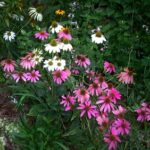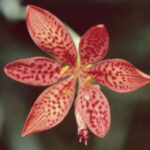One of the easiest perennial flower plants to grow has to be the bearded iris and it doesn’t hurt that it’s also one of the most beautiful flowers, with hundreds of rainbow hued varieties to choose from.
July and August are prime months of ordering, planting, and dividing iris plants, although you can plant through September and still get enough root growth to make it through a zone 7 winter. Bearded iris do not require a cold winter hardening off to produce bloom the following spring, but yet they will survive it. It’s been said, that you can’t kill them!
Iris are not really bulbs, although most home gardners consider them to be a bulb. They are a rhizome, or a root plant and it is from the roots that these hardy flowers can become hundreds more plants, by simply digging up the roots after flowering period is over and dividing them into two or more plants.
Iris breeders and growers have developed hundreds of breeds with beautiful, enticing names that just beg you to purchase them and watch them flower. While you can still grow and purchase the simple lavender and purple blue iris of our grandmother’s gardens, you can also find iris breeds labeled; Fresno Frolic, Monet’s Blue, Tiger Honey, Night Ruler or my new favorite, Mariposa Skies, a vision of ruffles and lace in blue and white.
Iris flowers have six main flower petals that are arranged with three growing upward called Standards, and three that hang down called Falls. On the falls are fuzzy hair like strands called the beard, hence the name, bearded iris. Some are all one color, and this flower breed is categorized as a Self breed. But many have different colored Standards and Falls, with blending that ranges across the color spectrum even a true black flower.
My love for iris’s began as a young girl as I watched my mother grow them in sweeping fields. She was a breeder and a grower and people came from far away to peruse her field of flowers and purchase starts for their own iris and lily gardens. Late May and through June is prime bloom time in Indiana for iris, a time that I still look forward to every year with anticipation. My only dislike of bearded iris iwas that their blooming season was too short! I would have them all season long in my garden, if I could!
And now we can! With the new Reblooming breeds on the market! And Marisposa Skies is a reblooming breed! I can’t wait to see the blooms in my new iris beds this fall!
Planting and growing bearded iris
Location: Select an airy spot that gets 6-8 hours of sunlight daily. Avoid midday sun in the hot southern states.
Soil: Prepare your soil by digging up to 12 inches deep, add in good compost mix or fertilizer for blooming plants. Add some sand if you have hard clay soil and make sure there is good drainage in rainy areas.
Plant: Dig a shallow, hole, set the rizome, with leaves attached, pointing upward on a raised mound inside the larger hole. Refill the hole with your displaced dirt, with the rhizome even with the ground or even slightly above ground level. Don’t bury too much dirt around the stem of the leaves.
Watering: Water will during dry weather, but otherwise, no need. And I don’t even bother much with watering period, unless we truly are in kind of drought conditions.
Mulch: During very cold regions, and in exposed plots, a straw or leaf mulch is a good idea, although in my zone 7, I don’t mulch my iris. Make sure you remove any mulch in the spring, clean away old plant debris in the fall.
Feritlize: I always apply a light scattering of some bonemeal in the spring or a 6-10-10 fertilizer mix and that’s it until the fall, when I do the same thing again to feed before winter.
Here are some great sites to order your own beautiful bearded iris. It’s planting time now!
American Meadows:
White Flower Farm
Schreiners Gardens
Holland Bulb Farms




